Discrimination of Muscovitisation Processes Using a Modified Quartz–Feldspar Diagram: Application to Beauvoir Greisens
Abstract
:1. Introduction
2. Materials and Methods
2.1. Samples
2.2. Bulk Rock Analyses
- Panasqueira: Two distinct granites are affected by greisens (partially greisenised G1, granite inferred as the main biotite granite) and pseudo-greisens affecting the G4 Rare Metal Granite from the cupola [6]. Two data sets are available: those from [6,20], which are mainly concerned with the cupola.
- Cinovec greisens occur as steep or flat zones of intensive metasomatic greisenisation along tens to hundreds of meters [7,24]. Feldspars are replaced by quartz, zinnwaldite, topaz, and fluorite. Cinovec granite geochemistry has been covered in numerous papers. However, the number of studies of greisens or greisenised granites is low. The authors of [6,7,18,25] have provided a series of whole-rock analyses on granites undergoing greisenisation. In greisen, zinnwaldite is re-equilibrated and then muscovitised [8].
- Cligga Head: Greisens conserve their granite texture and consist of quartz, protolithionite (inherited from the granite), muscovite, tourmaline, and topaz [8]. Hall [9] considers that quartz represents 52% (modal), muscovite 40%, tourmaline 5%, and topaz 0.8% of the greisen composition. The albite is entirely replaced by muscovite. Muscovite is already more abundant than protolithionite in the granite, but its abundance increases in the greisen, where protolithionite disappears [10]. Muscovites from greisen contain lithium around 2500 ppm Li2O. A few whole-rock analyses are available in [10].
- In China, in the Zhengchong granite, several greisens were described by Liu et al. [21]. The greisen I is mainly composed of quartz (50%–55%), zinnwaldite (25%–30%), topaz (5%–10%), and fluorite (~5%). Greisen II exhibits a porphyritic-like texture where matrix and phenocrysts are observed. The matrix is mainly composed of quartz (45%–55%), zinnwaldite (15%–25%), topaz (10%–15%), and fluorite (~5%).
- In Hoggar, several greisens from the area Tamanrasset in the Pan-African Hoggar appear to result from two processes: the formation of quartz–topaz and quartz-rich greisens, followed by a quartz dissolution and its replacement by Li-rich micas, thus forming mica-rich greisens [22].
2.3. Method for Graphically Processing Geochemical Data: The Q’-F’ Diagram
3. Results
3.1. Mineralogical Analysis of Beauvoir Granite and Greisen
3.2. Diagram Q’-F’ Applied to Granites and Greisens
3.2.1. Beauvoir Alteration Suite
3.2.2. Panasqueira
3.2.3. Other Examples
Cligga Head and Cinovec
The Zhengchong and Hoggar Greisens
4. Discussion
4.1. Main Trend for the Beauvoir Granite
4.2. Differences among the Other Greisen Examples
4.3. Aluminium Mobility and Muscovite Development
4.4. Silicification in the Granite Mass or Quartz Dissolution and Quartz Vein Formation
5. Conclusions
Supplementary Materials
Author Contributions
Funding
Data Availability Statement
Acknowledgments
Conflicts of Interest
References
- Černý, P.; Masau, M.; Goad, B.E.; Ferreira, K. The Greer Lake leucogranite, Manitoba, and the origin of lepidolite-subtype granitic pegmatites. Lithos 2005, 80, 305–321. [Google Scholar] [CrossRef]
- Černý, P.; Blevin, P.L.; Cuney, M.; London, D. Granite-related ore deposits. Econ. Geol. 2005, 100, 37–370. [Google Scholar]
- Shcherba, G.N. Greisens. Int. Geol. Rev. 1970, 12, 114–150. [Google Scholar] [CrossRef]
- Štemprok, M. Greisenization (a review). Geol. Rundsch. Stuttg. 1987, 76, 169–175. [Google Scholar] [CrossRef]
- Marignac, C.; Cuney, M.; Cathelineau, M.; Lecomte, A.; Carocci, E.; Pinto, F. The Panasqueira rare metal granite suites and their involvement in the genesis of the world-class Panasqueira W-Sn-Cu vein deposit: A petrographic, mineralogical, and geochemical study. Minerals 2020, 10, 562. [Google Scholar] [CrossRef]
- Breiter, K.; Ďurišová, J.; Hrstka, T.; Korbelová, Z.; Vaňková, M.H.; Galiova, M.V.; Kanicky, V.; Rambousek, P.; Knesl, I.; Dobes, P.; et al. Assessment of magmatic vs. metasomatic processes in rare-metal granites: A case study of the Cínovec/Zinnwald Sn–W–Li deposit, Central Europe. Lithos 2017, 292–293, 198–217. [Google Scholar] [CrossRef]
- Breiter, K.; Hložková, M.; Korbelová, Z.; Galiová, M.V. Diversity of lithium mica compositions in mineralised granite-greisen system: Cínovec Li-Sn-W deposit, Erzgebirge. Ore Geol. Rev. 2019, 106, 12–27. [Google Scholar] [CrossRef]
- Charoy, B. Greisenisation, minéralisation et fluides associés à Cligga Head, Cornwall (Sud-ouest de l’Angleterre). Bull. Mineral. 1979, 102, 633–641. [Google Scholar] [CrossRef]
- Hall, A. Greisenisation in granite of Cligga Head, Cornwall. Proc. Geol. Assoc. 1971, 82, 209–230. [Google Scholar] [CrossRef]
- Cuney, M.; Marignac, C.; Weisbrod, A. The Beauvoir topaz-lepidolite albite granite (Massif Central, France); the disseminated magmatic Sn–Li–Ta–Nb–Be mineralisation. Econ. Geol. 1992, 87, 1766–1794. [Google Scholar] [CrossRef]
- Monnier, L.; Salvi, S.; Jourdan, V.; Sall, S.; Bailly, L.; Melleton, J.; Béziat, D. Contrasting fluid behavior during two styles of greisen alteration leading to distinct wolframite mineralisations: The Echassières district (Massif Central, France). Ore Geol. Rev. 2020, 124, 103648. [Google Scholar] [CrossRef]
- Monnier, L.; Salvi, S.; Melleton, J.; Lach, P.; Pochon, A.; Bailly, L.; Béziat, D.; Parseval, P.D. Mica trace-element signatures: Highlighting superimposed W-Sn mineralisations and fluid sources. Chem. Geol. 2022, 600, 120866. [Google Scholar] [CrossRef]
- Monier, G.; Charoy, B.; Cuney, M.; Ohnenstetter, D.; Robert, J.L. Évolution spatiale et temporelle de la composition des micas du granite albitique a topaze-lepidolite de Beauvoir. Geol. Fr. 1987, 2–3, 179–188. [Google Scholar]
- Do Couto, D.; Faure, M.; Augier, R.; Cocherie, A.; Rossi, P.; Li, X.-H.; Lin, W. Monazite U–Th–Pb EPMA and zircon U–Pb SIMS chronological constraints on the tectonic, metamorphic, and thermal events in the inner part of the Variscan orogen, example from the Sioule series, French Massif Central. Int. J. Earth Sci. 2016, 105, 557–579. [Google Scholar] [CrossRef]
- Fonteilles, M. La composition chimique des micas lithinifères (et autres minéraux) des granites d’Echassières comme image de leur évolution magmatique. Geol. Fr. 1987, 2–3, 149–178. [Google Scholar]
- Rossi, P.; Autran, A.; Azencott, C.; Burnol, L.; Cuney, M.; Johan, V.; Kosakevitch, A.; Ohnenstetter, D.; Monier, G.; Piantone, P.; et al. Logs pétrographique et géochimique du granite de Beauvoir dans le sondage “échassieres I” Minéralogie et géochimie comparées. Géol. Fr. 1987, 2–3, 111–135. [Google Scholar]
- Cathelineau, M. The hydrothermal alkali metasomatism effects on granitic rocks: Quartz dissolution and related subsolidus changes. J. Petrol. 1986, 27, 945–965. [Google Scholar] [CrossRef]
- Štemprok, M. Drill hole CS-1 penetrating the Cínovec/Zinnwald granite cupola (Czech Republic): An A-type granite with important hydrothermal mineralisation. J. Geosci. 2016, 61, 395–423. [Google Scholar] [CrossRef]
- Hreus, S.; Výravský, J.; Cempírek, J.; Breiter, K.; Galiová, M.V.; Krátký, O.; Šešulka, V.; Skoda, R. Scandium distribution in the world-class Li-Sn-W Cínovec greisen-type deposit: Result of a complex magmatic to hydrothermal evolution, implications for scandium valorisation. Ore Geol. Rev. 2021, 139, 104433. [Google Scholar] [CrossRef]
- Launay, G.; Sizaret, S.; Lach, P.; Melleton, J.; Gloaguen, E.; Poujol, M. Genetic relationship between greisenization and Sn-W mineralisations in vein and greisen deposits: Insights from the Panasqueira deposit (Portugal). Bull. Soc. Geol. Fr. 2021, 192, 2. [Google Scholar] [CrossRef]
- Liu, C.; Xiao, W.; Zhang, L.; Belousova, E.; Rushmer, T.; Xie, F. Formation of Li-Rb-Cs greisen-type deposit in Zhengchong, Jiuyishan district, South China: Constraints from whole-rock and mineral geochemistry. Geochemistry 2021, 81, 125796. [Google Scholar] [CrossRef]
- Bouguebrine, J.; Bouabsa, L.; Marignac, C. Greisen and pseudo-greisen in the Tamanrasset area (Central Hoggar, Algeria): Petrography, geochemistry and insight on the fluid origin from mica chemistry. J. Afr. Earth Sci. 2023, 202, 104898. [Google Scholar] [CrossRef]
- Carignan, J.; Hild, P.; Mevelle, G.; Morel, J.; Yeghicheyan, D. Routine analyses of trace elements in geological samples using flow injection and low pressure on line liquid chromatography coupled to ICP-MS: A study of geochemical reference material BR, DR-N, EB-N, AN-G and GH. Geostand. Newsl. 2001, 25, 187–198. [Google Scholar] [CrossRef]
- Johan, Z.; Strnad, L.; Johan, V. Evolution of the Cínovec (Zinnwald) granite cupola, Czech Republic: Composition of feldspars and micas, a clue to the origin of W, Sn mineralisation. Can. Mineral. 2012, 50, 1131–1148. [Google Scholar] [CrossRef]
- Stemprok, M.; Sulcek, Z. Geochemical Profile through an Ore-Bearing Lithium Granite. Econ. Geol. 1969, 64, 392–404. [Google Scholar] [CrossRef]
- La Roche, H. Sur l’usage du concept d’association minérale dans l’étude chimique des roches: Modèles chimiques, statistiques, représentations graphiques, classification chimico minéralogique. C.R. Acad. Sci. Paris 1966, 262, 1665–1668. [Google Scholar]
- Debon, F.; Le Fort, P.A. Cationic classification of common plutonic rocks and their magmatic associations: Principles, method, applications. Bull. Minéralogie 1988, 111, 493–510. [Google Scholar] [CrossRef]
- Streckeisen, A.L. Classification and nomenclature of plutonic rocks. Geol. Rundsch. 1974, 63, 773–786. [Google Scholar] [CrossRef]
- Streckeisen, A.L. Classification of the common igneous rocks by means of their chemical composition. Neues Jahrb Miner. Monatsh 1976, 1, 1–15. [Google Scholar]
- Michaud, J.A.S.; Pichavant, M. Magmatic fractionation and the magmatic-hydrothermal transition in rare metal granites: Evidence from Argemela (central Portugal). Geochim. Cosmochim. Acta 2020, 289, 130–157. [Google Scholar] [CrossRef]
- Antunes, I.M.; Neiva, A.M.; Ramos, J.M.; Silva, P.B.; Silva, M.M.; Corfu, F. Petrogenetic links between lepidolite-subtype aplite-pegmatite, aplite veins and associated granites at Segura (Central Portugal). Geochemistry 2013, 73, 323–341. [Google Scholar] [CrossRef]
- Cathelineau, M.; Boiron, M.C.; Leconte, A.; Martins, I.; Dias da Silva, I.; Mateus, A. Lithium, phosphorus, fluorine-rich intrusions and the phosphate sequence at Segura (Portugal): A comparison with other hyper-differentiated magmas. Minerals 2024, 14, 287. [Google Scholar] [CrossRef]
- Tuttle, O.F.; Bowen, N.L. Origin of granite in the light of experimental studies in the system NaAlSi3O8-KAlSi3O8-SiO2-H2O. Geol. Soc. Am. 1958, 74, 153. [Google Scholar]
- Kahou, S.; Cathelineau, M.; Boiron, M.-C. Quantitative mineralogy and lithium distribution in the upper part of the Beauvoir granite. In Proceedings of the EGU24-2024, Vienna, Austria, 14–19 April 2024. 1668-ECS, Orals, GMPV5.1. [Google Scholar]
- Gresens, R.L. Composition-volume relationships of metasomatism. Chem. Geol. 1967, 2, 47–55. [Google Scholar] [CrossRef]
- Pinto, F.M.V. ICP-MS Data of the SCB2 Drill-Hole. Beiralt Tin and Wolfram (Portugal) Data. Beiralt Tin and Wolfram (Portugal) Mining Company; Unpublished Report, 2016. [Google Scholar]
- Errandonea-Martin, J.; Garate-Olave, I.; Roda-Robles, E.; Cardoso-Fernandes, J.; Lima, A.; Ribeiro, M.A.; Teodoro, A.C. Metasomatic effect of Li-bearing aplite-pegmatites on psammitic and pelitic metasediments: Geochemical constraints on critical raw material exploration at the Fregeneda–Almendra Pegmatite Field (Spain and Portugal). Ore Geol. Rev. 2022, 150, 105155. [Google Scholar] [CrossRef]
- Lentz, D.R.; Gregoire, C. Petrology and mass-balance constraints on major-, trace-, and rare-earth-element mobility in porphyry-greisen alteration associated with the epizonal True Hill granite, southwestern New Brunswick, Canada. J. Geochem. Explor. 1995, 52, 303–331. [Google Scholar] [CrossRef]
- Burt, D.M. Acidity-salinity diagrams–Application to greisen and porphyry deposits. Econ. Geol. 1981, 76, 832–843. [Google Scholar] [CrossRef]
- Harlaux, M.; Mercadier, J.; Bonzi, W.M.E.; Kremer, V.; Marignac, C. Geochemical signature of magmatic-hydrothermal fluids exsolved from the Beauvoir rare-metal granite (Massif Central, France): Insights from LA-ICPMS analysis of primary fluid inclusions. Geofluids 2017, 2017, 1925817. [Google Scholar] [CrossRef]
- Tagirov, B.; Schott, J. Aluminum speciation in crustal fluids revisited. Geochim. Cosmochim. Acta 2001, 65, 3965–3992. [Google Scholar] [CrossRef]
- Aissa, M.; Weisbrod, A.; Marignac, C. Chemical and thermodynamic characteristics of hydrothermal fluid circulation at Echassieres. Geol. Fr. 1987, 2–3, 335–350. [Google Scholar]
- Aubert, G. Les coupoles granitiques de Montebras et d’Echassières (Massif central français) et la genèse de leurs minéralisations en étain, lithium, tungstène et béryllium. Éditions BRGM 1969, 46, 1. [Google Scholar]
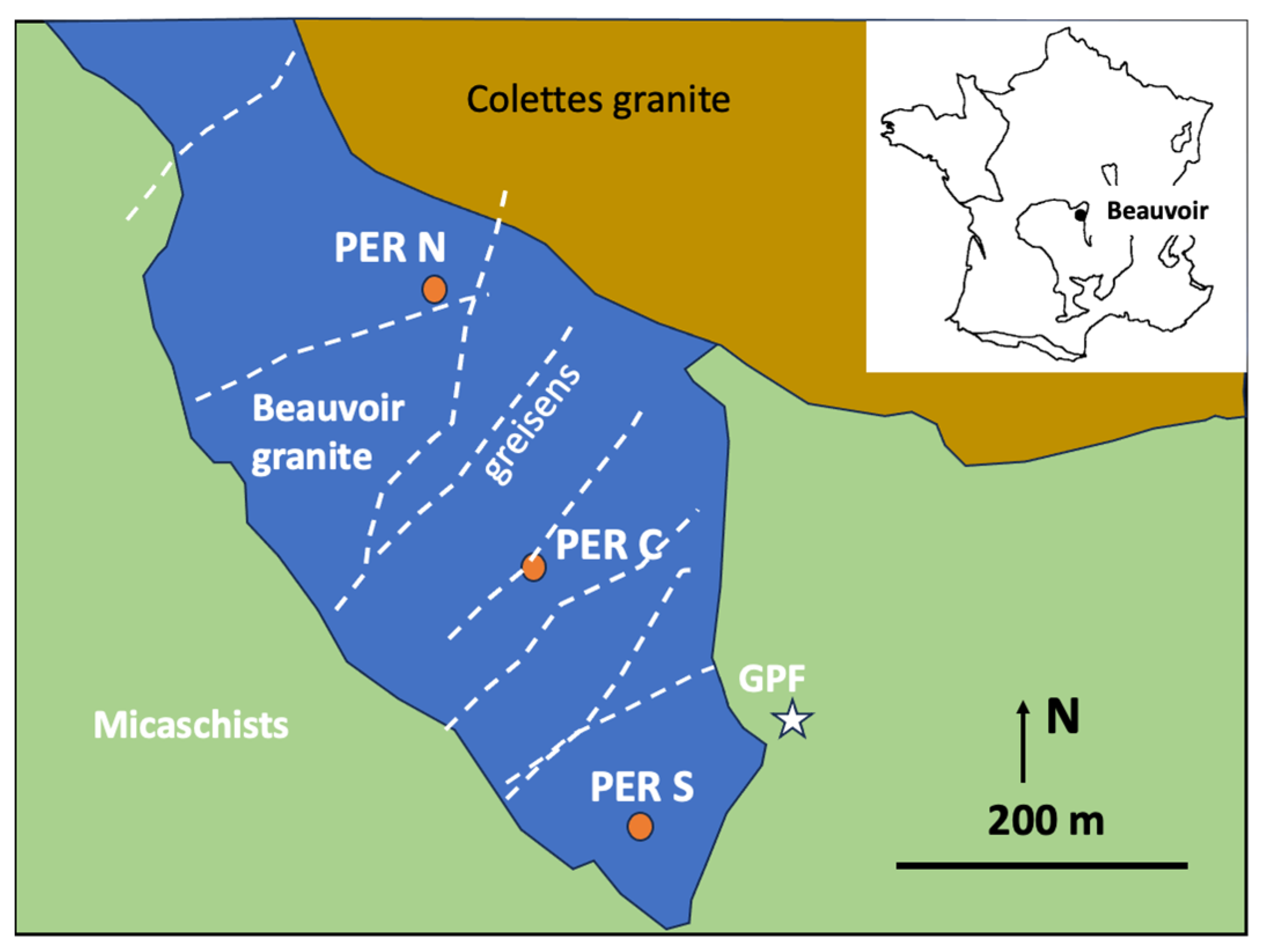

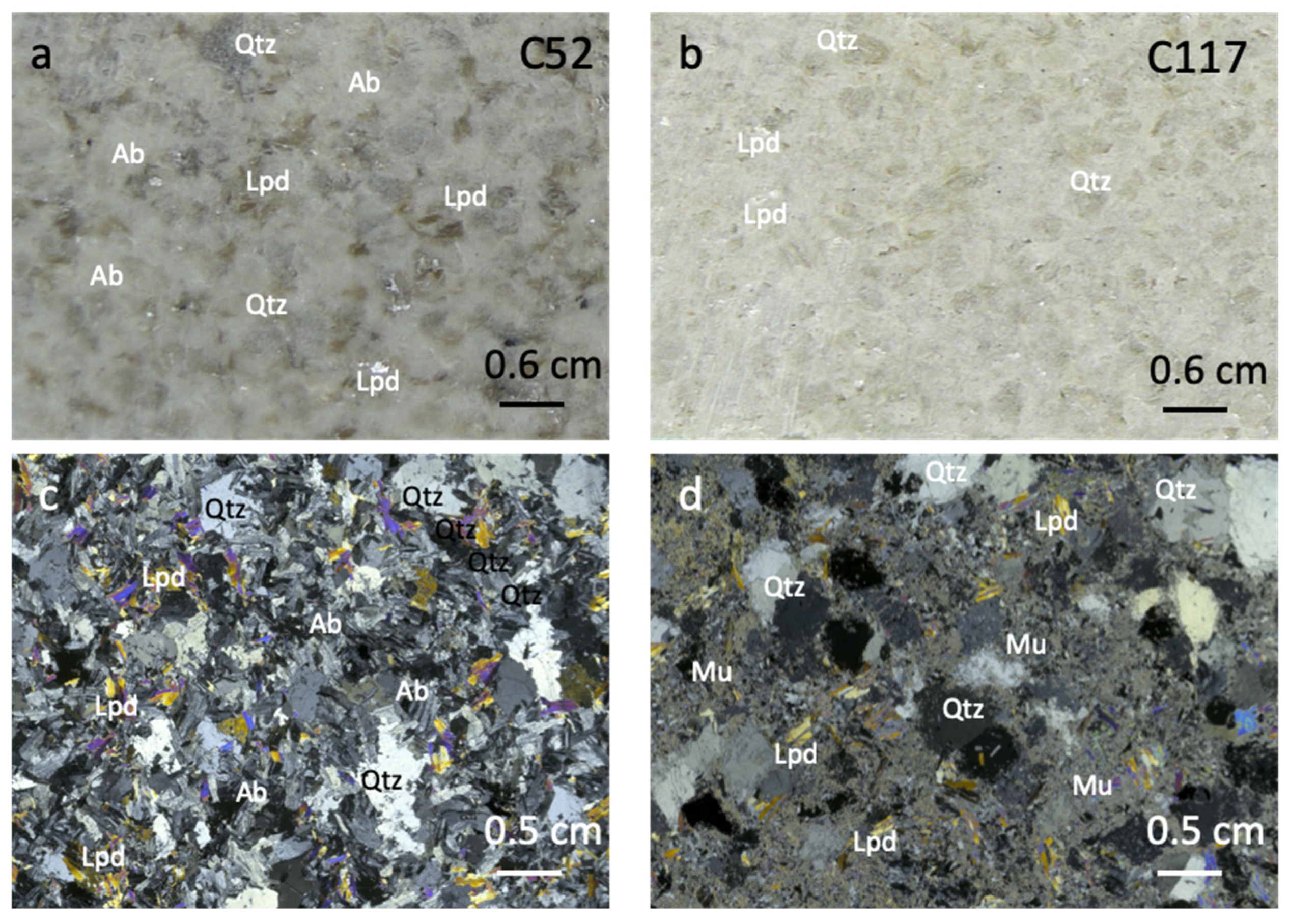
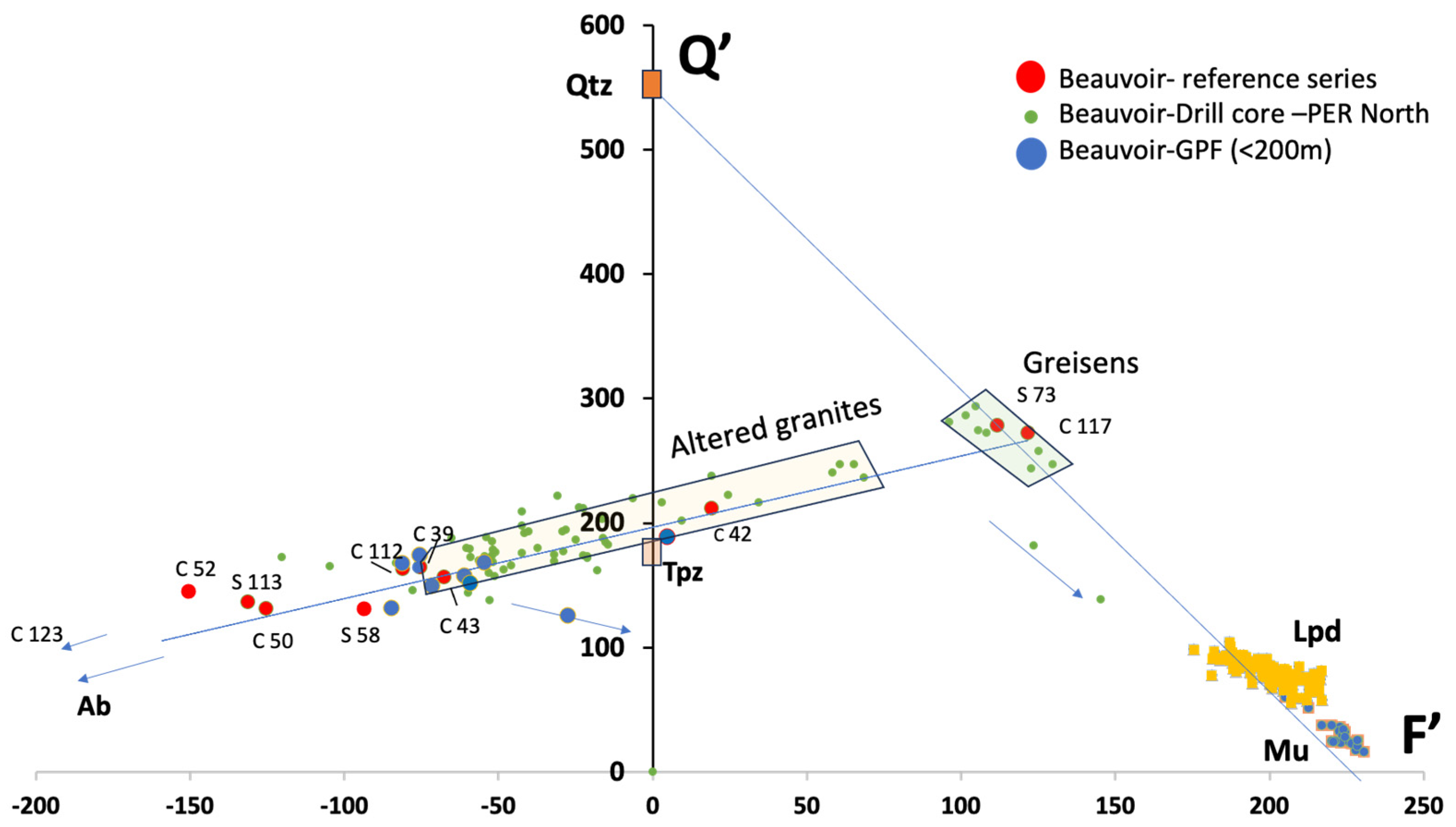
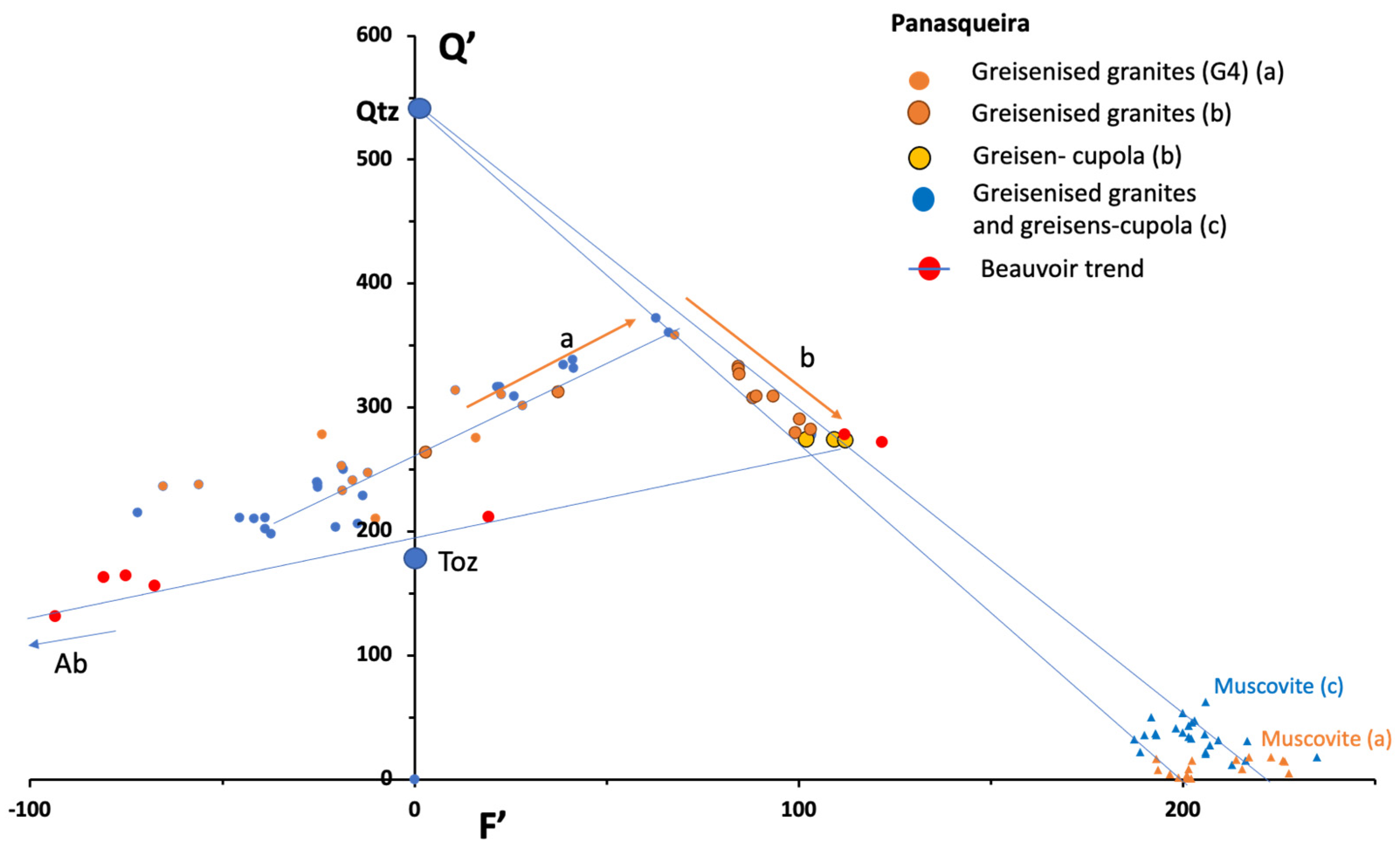


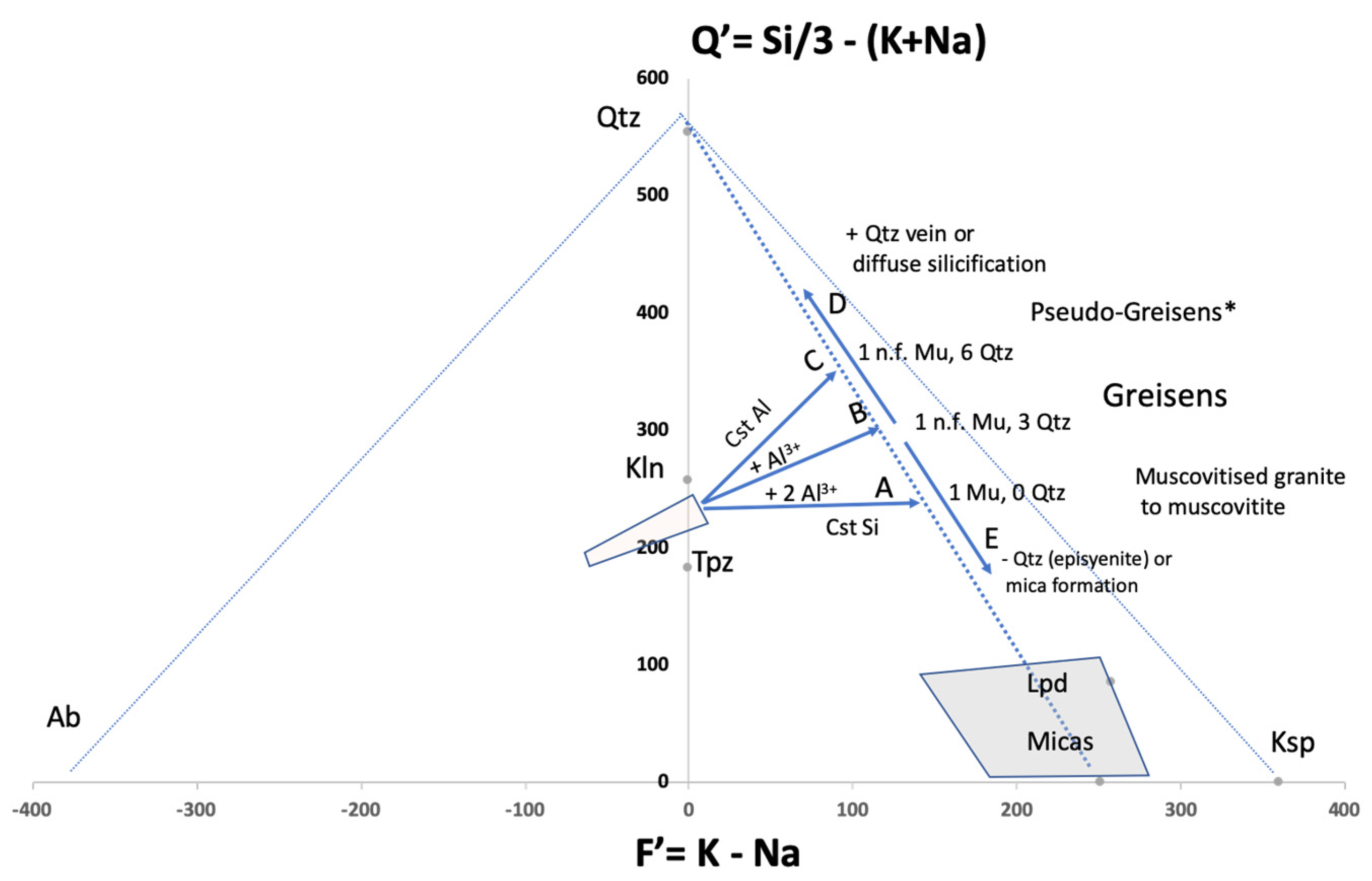
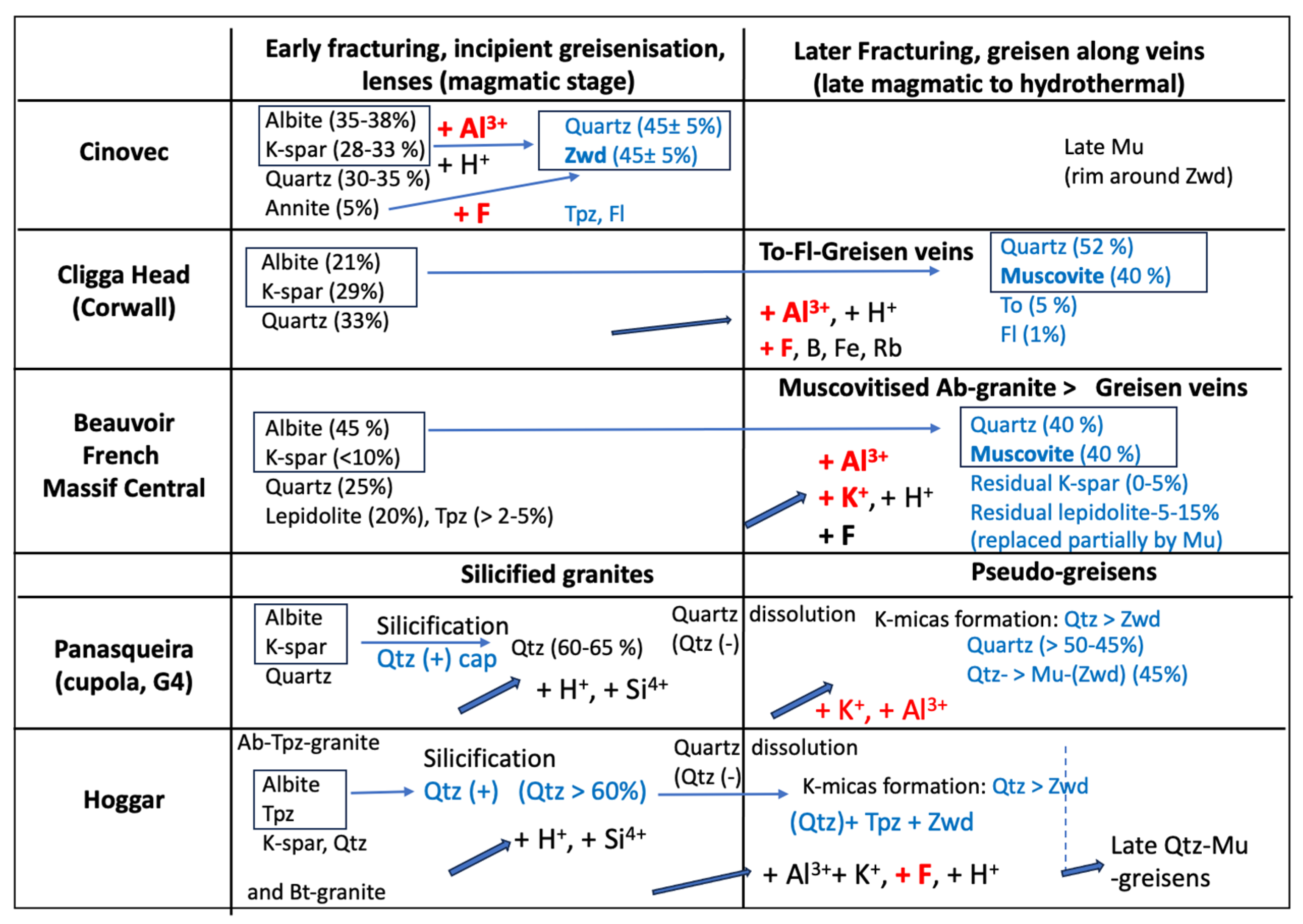
| Sample | C123 | C52 | S113 | C30 | S58 | C112 | C39 | C43 | C42 | S73 | C117 |
|---|---|---|---|---|---|---|---|---|---|---|---|
| Fresh Granites | Altered Granites | Greisens | |||||||||
| SiO2 | 66.68 | 68.24 | 68.96 | 68.45 | 68.08 | 69.50 | 67.94 | 65.49 | 65.35 | 71.38 | 72.28 |
| TiO2 | 0.00 | 0.00 | 0.00 | 0.00 | 0.00 | 0.00 | 0.00 | 0.00 | 0.00 | 0.00 | 0.00 |
| Al2O3 | 19.35 | 17.28 | 18.19 | 18.13 | 17.31 | 17.69 | 18.02 | 18.12 | 17.54 | 18.22 | 17.88 |
| Fe2O3 | 0.06 | 0,13 | 0.08 | 0.05 | 0.05 | 0.10 | 0.07 | 0.17 | 0.25 | 0.10 | 0.07 |
| FeO | bdl | 0.80 | 0.30 | 0.08 | 0.15 | 0.14 | 0.05 | 0.19 | 0.18 | 0.10 | 0.12 |
| MnO | 0.02 | 0.09 | 0.04 | 0.04 | 0.02 | 0.07 | 0.05 | 0.04 | 0.06 | 0.05 | 0.06 |
| MgO | 0.00 | 0.00 | 0.05 | 0.00 | 0.00 | 0.00 | 0.00 | 0.06 | 0.12 | 0.03 | 0.04 |
| CaO | 0.33 | 0.75 | 0.30 | 0.28 | 0.54 | 0.68 | 0.69 | 1.40 | 2.07 | 0.62 | 0.10 |
| Na2O | 10.36 | 5.95 | 5.84 | 5.80 | 5.26 | 4.70 | 4.46 | 4.25 | 2.04 | 0.09 | 0.11 |
| K2O | 0.90 | 1.95 | 2.70 | 2.90 | 3.60 | 3.33 | 3.23 | 3.28 | 4.00 | 5.40 | 5.89 |
| P2O5 | 0.50 | 2.45 | 0.35 | 1.14 | 1.21 | 1.26 | 1.09 | 1.29 | 1.62 | 0.51 | 0.10 |
| L.O.I. | 1.22 | 2.85 | 2.39 | 2.45 | 2.53 | 2.50 | 3.26 | 3.84 | 5.67 | 3.27 | 2.97 |
| F | 0.44 | 2.18 | 1.95 | 2.39 | 1.67 | 1.92 | 2.50 | 2.68 | 2.03 | 1.00 | 0.87 |
| Total | 99.43 | 100.56 | 99.22 | 99.32 | 98.76 | 99.99 | 98.86 | 98.14 | 98.93 | 99.78 | 99.53 |
| F’ | −315.0 | −150.5 | −131.2 | −125.4 | −93.5 | −81.0 | −75.3 | −67.7 | 19.1 | 111.8 | 121.6 |
| Q’ | 16.6 | 145.3 | 136.7 | 131.1 | 131.4 | 163.2 | 164.4 | 156.5 | 211.7 | 278.4 | 272.4 |
Disclaimer/Publisher’s Note: The statements, opinions and data contained in all publications are solely those of the individual author(s) and contributor(s) and not of MDPI and/or the editor(s). MDPI and/or the editor(s) disclaim responsibility for any injury to people or property resulting from any ideas, methods, instructions or products referred to in the content. |
© 2024 by the authors. Licensee MDPI, Basel, Switzerland. This article is an open access article distributed under the terms and conditions of the Creative Commons Attribution (CC BY) license (https://creativecommons.org/licenses/by/4.0/).
Share and Cite
Cathelineau, M.; Kahou, Z.S. Discrimination of Muscovitisation Processes Using a Modified Quartz–Feldspar Diagram: Application to Beauvoir Greisens. Minerals 2024, 14, 746. https://doi.org/10.3390/min14080746
Cathelineau M, Kahou ZS. Discrimination of Muscovitisation Processes Using a Modified Quartz–Feldspar Diagram: Application to Beauvoir Greisens. Minerals. 2024; 14(8):746. https://doi.org/10.3390/min14080746
Chicago/Turabian StyleCathelineau, Michel, and Zia Steven Kahou. 2024. "Discrimination of Muscovitisation Processes Using a Modified Quartz–Feldspar Diagram: Application to Beauvoir Greisens" Minerals 14, no. 8: 746. https://doi.org/10.3390/min14080746






